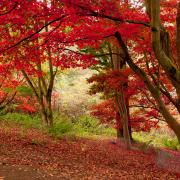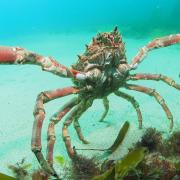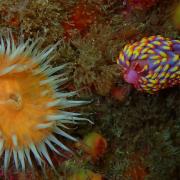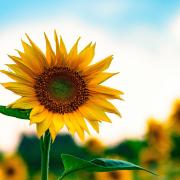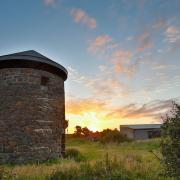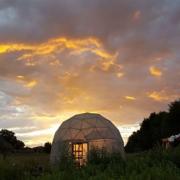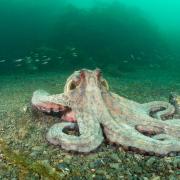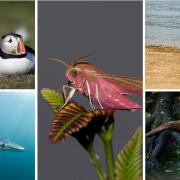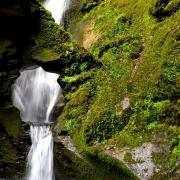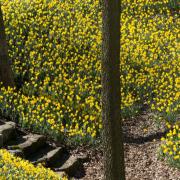Winter around Cornwall is full of excellent wildlife-spotting opportunities, writes Rowena Millar from the Cornwall Wildlife Trust.
Cornwall is a great place for birdwatching. Beautiful estuaries cut into our ancient land from north and south, attracting great numbers of wintering waders and wildfowl, from ducks and geese to herons and egrets. There are many nature reserves and bird hides waiting to be discovered. North-coast estuaries include the Camel, Gannel and Hayle rivers, with channels and sandbanks that change constantly. Deep estuaries or drowned river valleys on the south coast include the beautiful Fal, Helford, Fowey and Tamar. Those of us who live further inland can venture onto the hills and moors to look for birds of prey. Majestic buzzards survey the wintry fields at this time of year but on certain areas of moorland and heathland you may be lucky enough to see rarities such as the hen harrier. When visiting the lush woodland of Cornwall’s river valleys you will see the varied hues of mosses, lichens and fungi. Many smaller birds such as tits and finches will be gathered here in mixed groups. Woodpeckers, nuthatches and treecreepers will be busy searching for food on the trunks of older trees. You might assume that many animals will be out of sight in winter. Dormice, hedgehogs and bats hibernate and only wake in mild weather, but deer, badgers, otters, squirrels, foxes and moles are active throughout the season. Badgers are most obvious above ground once the cubs have been born in late winter, but there is still plenty of foraging, scuffling and even snoring to be witnessed by the keen wildlife watcher. Grey squirrels betray their presence by rustling, dropping twigs from above and often foraging boldly on the ground. They eat softer fruits and nuts in autumn, instinctively knowing that harder nuts can be buried and dug up intact later, when times are hard. Although dormice are elusive, even when awake, winter is an excellent time to look for signs that they are around. Rummaging amongst fallen leaves in hazel thickets, you may see nuts that have been nibbled. A smooth, perfect hole with outward sloping edges on the side of the nut is a telltale sign of dormouse activity. Please report dormouse-nibbled nuts to the Environmental Records Centre for Cornwall and the Isles of Scilly (ERCCIS), hosted by Cornwall Wildlife Trust on 01872 273939 or visit www.erccis.co.uk. More common garden visitors are the bank vole and the wood mouse. Listen out for rustling in hedge banks when you are out in the countryside; it’s a good sign that a mouse or vole is nearby. In harsh weather you might see foxes out and about in broad daylight.Listen out for rustling in hedge banks when you are out in the countryside, it’s a good sign that a mouse or vole is nearbyWoodland walks may also offer tantalising glimpses of deer seen through bare tree trunks. The white, heart-shaped rumps of retreating roe deer are easy to identify. Roe and red deer can be found on quite open places such Goss Moor and are common in the woods and fields of East Cornwall. Thanks to our mild climate, winter is a good time to hear and see spawning frogs in Cornwall, with plenty of spawn appearing in January. The amorous amphibians can be indentified by rasping croaks. Toads spend more time on dry land than frogs, but will emerge from hibernation by the early spring to lay long strings of spawn in still water. Many of Cornwall Wildlife Trust’s nature reserves contain ponds which benefit a wide range of wild creatures from birds to dragonflies. In mild weather the occasional butterfly lends a splash of colour to a wintry scene, and plants such as the red campion persist in flowering on hostile wintry days. Kingfishers add a vibrant flash of colour during the winter as they whizz low over rivers. Don’t forget the coastline in winter. The crashing waves may well wash some interesting wildlife onto the beach, such as the strange jellyfish-like creatures known as ‘velella’ or ‘by-the-wind sailors’. Rockpooling can also be a year-round occupation. The extreme South West at Gwennap Head is good for spotting dolphins and other marine mammals, while seals haul up on beaches around Cornwall and appear at St Ives harbour during high tides. You may see seal heads bobbing in the water near a beach or heavy bodies hauled out to breed in late autumn, to moult in late winter or simply to rest and digest fish. It is advisable to stay well back and preferably out of sight, so as not to disturb them. Please do report entangled seals or any other marine mammal casualties to the British Divers Marine Life Rescue on 01825 765546. The Cornwall Wildlife Trust Marine Strandings Network is the official recorder for all marine strandings in Cornwall. Its website is www.cwtstrandings.org, while help for seals is offered by the Seal Sanctuary at Gweek.All wildlife sightings, common or rare, are welcomed by ERCCIS. All records are important and help towards future wildlife conservation. Visit www.erccis.co.uk/wildlife or call Cornwall Wildlife Trust’s Wildlife Information Service on 01872 240777, ext 213. For further information about Cornwall Wildlife Trust call 01872 273939, or visit www.cornwallwildlifetrust.co.uk.Where to see wildlife in winterChurchtown Farm Community Nature Reserve, Saltash: See goldfinches on arable fields and waders on the estuary.Marsland Valley Nature Reserve, North Cornwall/Devon border: A large and diverse nature reserve with plenty of wildlife.Fox Corner Nature Reserve, Truro: Nature near the city – your chance to see a fox.Kennall Vale Nature Reserve, Ponsanooth (between Truro and Falmouth), and Luxulyan Valley and Golitha Falls: These sites have lush valley wildlife and scenery.Bissoe Valley Nature Reserve: A great place for amphibians.Tehidy Country Park, near Camborne: Best for squirrels, woodpeckers and kingfishers.Antony House Estate and Mount Edgcumbe: A good place to see deer.The Lost Gardens of Heligan, near Mevagissey: Watch wildlife indoors with CCTV coverage of badgers, barn owls, bat roosts and bird-feeding station.Kit Hill Country Park, Callington: See birds of prey, stonechat, Dartford warbler, foxes and deer.Where to see birds in winterAll the estuaries of Cornwall are great for bird spotting, as well as the following reserves and woods:Windmill Farm Nature Reserve, The Lizard: Wonderful for migrant birds, kestrels and barn owls.Bakers Pit Nature Reserve, Penwith: Great for birds of prey, look out for hen harrier, peregrine falcon and merlin.Maer Lake Nature Reserve, Bude: Experience a spectaculararray of migrant birds.Kilminorth Woods, Looe: For woodland wildlife and river birds.Marazion Marsh, near Penzance: This is Cornwall’s largest reedbed, where flocks of starlings visit some years, birds including bitterns and overwintering chiff-chaffs can be seen, plus many mammals and plants.Goonhilly Downs, The Lizard: Look out for merlin, hen harrier and short-eared owl.







